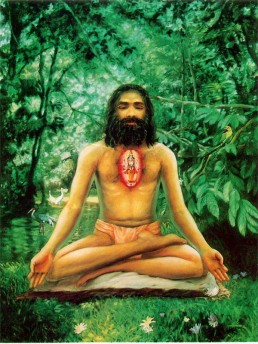Swami Chinmayananda
Swami Chinmayananda Commentary
Every student who tries to understand the above two verses and tries to put them into practice will despair at his own incapacity to control the mind and fix it constantly in the contemplation of the Self. In utter despair, every seeker will realise that the mind irresistibly wanders away from its point-of-concentration because the mind is, by its very nature, “restless” (Chanchala) and “unsteady” (A-sthira). It can neither constantly think of one object nor consistently think of different objects. By these two terms qualifying the mind — restlessness and unsteadiness — Krishna has brought out a vivid and a very realistic picture of the mind, as it is experienced by all true seekers striving on the path of Meditation. These two phrases are so impressive that later on Arjuna himself, while crystallising his doubts into language, uses them quite naturally.
Thus, during practice, even though the seeker has brought his sense-organs to a large extent under his control, still the mind, disturbed by the memories of its past experiences, will shoot out in search of sense-objects. These are the moments of dejection and despair for the seekers. These wanderings of the mind may be due to very many reasons: the memory of the past, the vicinity of some tempting objects, the association of ideas, some attachment or aversion, or maybe, even the very spiritual aspiration of the seeker. Lord Krishna’s instruction here is very categorical and all-embracing. He says “WHATEVER BE THE REASON BECAUSE OF WHICH THE RESTLESS AND THE UNSTEADY MIND WANDERS AWAY,” the seeker is not to despair, but should understand that it is the nature of the mind to wander, and that the very process of meditation is only a technique to stop this wandering.
LET HIM BRING IT BACK — The seeker is advised to bring back the mind that has rushed out into dissimilar channels of thinking. This withdrawal of the mind by sheer will-power may be successful to a degree, but as soon as it is brought back, it will, and it should, rush out again into another fanciful line of thinking. Very rarely do the Sadhakas realise that the mind means “the flow-of-thought.” A steady, motionless mind is no mind at all! Therefore, in the technique of meditation, when the mind is withdrawn from the sense-objects, this very process of withdrawal is to be completed by a conscious effort on the part of the meditator, in applying the same mind, at once, in the contemplation of the Self. This idea has been remarkably well brought out when the Lord complements his instruction by the term “BRINGING IT UNDER THE SWAY OF THE SELF ALONE.”
THE FOLLOWING FEW STANZAS EXPLAIN THE EFFECT OF THE ‘YOGA’ OF MEDITATION UPON ITS TRUE PRACTITIONERS:
Adi Sankara Commentary
In the beginning, the yogi who is thus engaged in making the mind established in the Self, etat vasamnayet, should bring this (mind) under the subjugation; atmani eva, of the Self Itself; niyamya, by restraining; etat. it; tatah tatah, from all those causes whatever, viz sound etc.; yatah yatah, due to which, doe to whatever objects like sound etc.; the cancalam, restless, very restless; and therefore asthiram, unsteady; manah, mind; niscarati, wanders away, goes out due to its inherent defects. (It should be restrained) by ascertaining through discrimination those causes to be mere appearances, and with an attitude of detachment. Thus, through the power of practice of Yoga, the mind of the yogi merges in the Self Itself.
The Bhagavad Gita with the commentary of Sri Sankaracharya – Translated by Alladi Mahadeva Sastry
Holy Geeta – Commentary by Swami Chinmayananda
The Bhagavad Gita by Eknath Easwaran – Best selling translation of the Bhagavad Gita
The Bhagavad Gita – Translation and Commentary by Swami Sivananda
Bhagavad Gita – Translation and Commentary by Bhaktivedanta Swami Prabupadha
Srimad Bhagavad Gita Chapter 6 – Verse 26 – 6.26 yato yato niscarati – All Bhagavad Gita (Geeta) Verses in Sanskrit, English, Transliteration, Word Meaning, Translation, Audio, Shankara Bhashya, Adi Sankaracharya Commentary and Links to Videos by Swami Chinmayananda and others – 6-26

